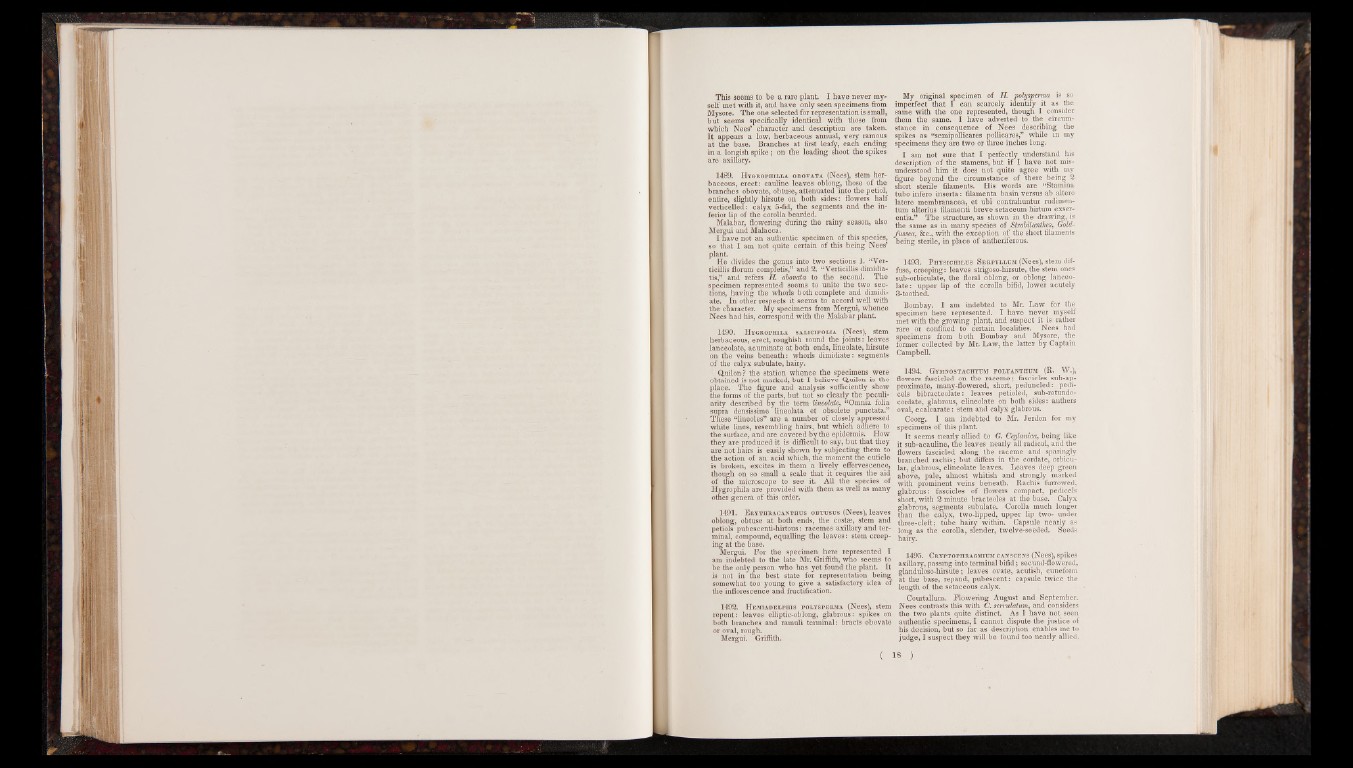
This seems to be a rare plant. I have never myself
met with it, and have only seen specimens from
Mysore. The one selected for representation is small,
but seems specifically identical with those from
which Nees’ character and description are taken.
It appears a low, herbaceous annual, very ramous
at the base. Branches at first leafy, each ending
in a longish spike; on the leading shoot the spikes
are axillary.
1489. Hygrophibla obovata (Nees), stem herbaceous,
erect: cauline leaves oblong, those of the
branches obovate, obtuse, attenuated into the petiol,
entire, slightly hirsute on both sides: flowers half
verticellea: calyx 5-fid, the segments and the inferior
lip of the corolla bearded.
Malabar, flowering during the rainy season, also
Mergui and Malacca.
I have not an authentic specimen of this species,
so that I am not quite certain of this being Nees’
plant.
He divides the genus into two sections 1. “Ver-
ticillis florum completis,” and 2. “Verticillis dimidia-
tis,” and refers H. obovata to the second. The
specimen represented seems to unite the two sections,
having the whorls both complete and dimidiate.
In other respects it seems to accord well with
the character. My specimens from Mergui, whence
Nees had his, correspond with the Malabar plant
1490. Hygrophila salicifolia (Nees), stem
herbaceous, erect, roughish round the joints: leaves
lanceolate, acuminate at both ends, Iineolate, hirsute
on the veins beneath: whorls dimidiate: segments
of the calyx subulate, hairy.
Q,uilon? the station whence the specimens were
obtained is not marked, but I believe Q-uilon is the
place. The figure and analysis sufficiently show
the forms of the parts, but not so clearly the peculiarity
described by the term Iineolate, “Omnia folia
supra densissime lineolata et obsolete punctata.”
These “lineoles” are a number of closely appressed
white lines, resembling hairs, but which adhere to
the surface, and are covered by the epidermis. How
they are produced it is difficult to say, but that they
are not hairs is easily shown by subjecting them to
the action of an acid which, the moment the cuticle
is broken, excites in them a lively effervescence,
though on so small a scale that it requires the aid
of the microscope to see it. All the species of
Hygrophila are provided with them as well as many
other genera of this order.
1491. E rythracanthus obtusus (Nees), leaves
oblong, obtuse at both ends, the cost*, stem and
petiols pubescenti-hirtous: racemes axillary and terminal,
compound, equalling the leaves: stem creeping
at the base.
Mergui. For the specimen here represented I
am indebted to the late Mr. Griffith, who seems to
be the only person who has yet found the plant. It
is not in the best state for representation being
somewhat too young to give a satisfactory idea of
the inflorescence ana fructification.
1492. Hemiadelphis polysperma (Nees), stem
repent: leaves elliptic-oblong, glabrous: spikes on
both branches and ramuli terminal: bracts obovate
or oval, rough.
Mergui. Griffith.
My original specimen of H. polysperma is so
imperfect that I can scarcely identify it as the
same with the one represented, though I consider
them the same. I have adverted to the circumstance
in consequence of Nees describing the
spikes as “semipollicares pollicares,” while in my
specimens they are two or three inches long.
I am not sure that I perfectly understand his
description of the stamens, but if I have not misunderstood
him it does not quite agree with my
figure beyond the circumstance o f there being 2
short sterile filaments. His words are “Stamina
tubo infero inserta: filamenta basin versus ab altero
latere membranacea, et ubi contrahuntur rudimen-
tum alterius filamenti breve setaceum hirtum exser-
entia.” The structure, as shown in the drawing, is
the same as in many species of Strobilanthes, Gold-
fussea, &c., with the exception of the short filaments
being sterile, in place of antheriferous.
1493. Physichilus S erpyllom (Nees), stem diffuse,
creeping: leaves strigoso-hirsute, the stem ones
sub-orbiculate, the floral oblong, or oblong lanceolate:
upper lip of the corolla bifid, lower acutely
3-toothed.
Bombay. I am indebted to Mr. Law for the
specimen here represented. I have never myself
met with the growing plant, and suspect it is rather
rare or confined to certain localities. Nees had
specimens from both Bombay and Mysore, the
former collected by Mr. Law, the latter by Captain
Campbell.
1494. Gymnostachyum polyanthum (R. W.),~
flowers fascicled on the raceme; fascicles sub-approximate,
many-flowered, short, peduncled: pedicels
bibracteoiate: leaves petioled, sub-rotundo-
cordate, glabrous, elineolate on both sides: anthers
oval, ecalcarate: stem and calyx glabrous.
Coorg. I am indebted to Mr. Jerdon for my
specimens of this plant.
It seems nearly allied to G. Ceylanica, being like
it sub-acauline, the leaves nearly all radical, and the
flowers fascicled along the raceme and sparingly
branched rachis; but differs in the cordate, orbicular,
glabrous, elineolate leaves. Leaves deep green
above, pale, almost whitish and strongly marked
with prominent veins beneath. Rachis furrowed,
glabrous: fascicles of flowers compact, pedicels
short, with 2 minute bracteoles at the base. Calyx
glabrous, segments subulate. Corolla much longer
than the calyx, two-lipped, upper lip two- under
three-cleft; tube hairy within. Capsule nearly as
long as the corolla, slender, twelve-seeded. Seeds
hairy.
1495. Cryptophragmium canscens (Nees), spikes
axillary, passing into terminal bifid; secund-flowered,
glanduloso-hirsute; leaves ovate, acutish, cuneform
at the base, repand, pubescent: capsule twice the
length of the setaceous calyx.
Courtallum. Flowering August and September.
Nees contrasts this with C. serrulatwn, and considers
the two plants quite distinct As I have not seen
authentic specimens, I cannot dispute the justice of
his decision, but so far as description enables me to
judge, I suspect they will be found too nearly allied.